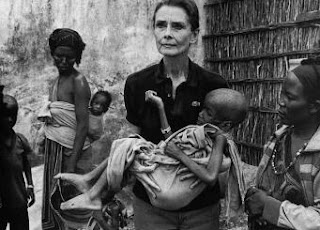Timelessness and grace, the life and work of the great Audrey Hepburn.
Audrey Hepburn's Life and Achievements
Audrey Hepburn is considered one of the most iconic actresses of all time, known for her beauty, elegance, and unique sense of style. However, her contributions to film and society extend far beyond her performances on screen. In this article, we will explore Audrey Hepburn's life and achievements, including her early years, Hollywood career, humanitarian work, personal life, and legacy.
Early Life
Audrey Hepburn was born on May 4, 1929, in Brussels, Belgium, to an English father and a Dutch mother. Her parents' marriage was rocky, and they divorced when Hepburn was just six years old. She moved to England with her mother, where she attended boarding school and developed a passion for ballet.
During World War II, Hepburn's family moved to the Netherlands, where she continued her ballet training and began performing in secret shows to raise money for the Dutch resistance. These experiences left a lasting impression on Hepburn and shaped her later commitment to humanitarian causes.
After the war, Hepburn moved to London to pursue a career in ballet but ultimately decided to transition to acting. She studied at the Royal Academy of Dramatic Art and made her stage debut in 1951 in the play "Gigi."
Hepburn's breakout role came in 1953, when she starred in the film "Roman Holiday" alongside Gregory Peck. The film was a critical and commercial success, and Hepburn won an Academy Award for her performance.
Throughout her career, Hepburn continued to captivate audiences with her talent and charisma, starring in iconic films such as "Breakfast at Tiffany's," "My Fair Lady," and "Charade." But beyond her accomplishments on screen, Hepburn's grace, elegance, and humanitarian work have earned her a place in history as a true icon and inspiration to millions around the world.
Career Beginnings
Hepburn's introduction to acting came when she was cast in a minor role in a Dutch film. Her breakout role came in 1951, when she starred in the British film, "The Lavender Hill Mob." She then landed the lead role in the Broadway play "Gigi," which brought her to the attention of Hollywood producers.
Hollywood Career
Hepburn's breakthrough role came in the 1953 film "Roman Holiday," for which she won an Academy Award for Best Actress. She went on to star in numerous successful films, including "Sabrina," "Breakfast at Tiffany's," and "My Fair Lady." Hepburn's performances were praised for their grace, charm, and emotional depth.
Humanitarian Work
In the 1980s, Hepburn shifted her focus to humanitarian work, becoming a Goodwill Ambassador for UNICEF. She traveled extensively, visiting impoverished communities around the world and advocating for children's rights. Her work with UNICEF earned her the Presidential Medal of Freedom in 1992, shortly before her death.
Audrey Hepburn's humanitarian work began in the early 1950s, when she first became involved with UNICEF. In 1954, she traveled to Ethiopia with UNICEF to witness the devastating effects of famine and poverty firsthand. This experience had a profound impact on Hepburn and sparked her lifelong commitment to humanitarian causes.
Throughout the 1950s and 1960s, Hepburn continued to work with UNICEF, traveling to numerous countries to raise awareness about issues such as malnutrition, lack of access to education, and child labor. She became a Goodwill Ambassador for UNICEF in 1988, a role in which she worked tirelessly to promote the organization's mission and raise funds for its programs.
Hepburn's work with UNICEF was not limited to raising awareness and funds. She also took a hands-on approach, visiting hospitals, schools, and refugee camps to meet with children and families in need. In 1992, she was awarded the Presidential Medal of Freedom in recognition of her humanitarian work.
Despite her untimely death in 1993, Audrey Hepburn's legacy as a humanitarian and advocate for children continues to inspire people around the world. Her work with UNICEF has helped to improve the lives of countless children and families, and her influence on the organization remains strong to this day.
Personal Life
Hepburn was married twice, first to actor Mel Ferrer and later to psychiatrist Andrea Dotti. She had two sons, Sean Ferrer and Luca Dotti. Hepburn's personal life was marked by tragedy, including the miscarriage of a third child and a difficult battle with cancer.
Legacy
Audrey Hepburn's legacy extends beyond her films and her humanitarian work. She is remembered for her distinctive sense of style, which has influenced fashion for generations. Her performances continue to captivate audiences around the world, and her work with UNICEF has inspired countless individuals to make a difference in the lives of children. Hepburn has been posthumously honored with numerous awards and recognition, including the Screen Actors Guild Lifetime Achievement Award and a place on the International Best Dressed List Hall of Fame.
Conclusion
In conclusion, Audrey Hepburn's life and achievements spanned far beyond her roles on screen. Her grace, elegance, and humanitarian work have inspired generations of individuals around the world. Hepburn's legacy continues to live on through her films, her work with UNICEF, and her enduring influence on fashion and popular culture.
FAQs
How did Audrey Hepburn die?
Audrey Hepburn passed away on January 20, 1993, at the age of 63, after a battle with abdominal cancer.
Was Audrey Hepburn a trained dancer?
Yes, Audrey Hepburn studied ballet as a child and considered becoming a professional dancer before transitioning to acting.
What was Audrey Hepburn's signature style?
Audrey Hepburn was known for her chic, minimalist style, often wearing simple yet elegant pieces such as black dresses, tailored pants, and classic trench coats.
Did Audrey Hepburn have any children?
Yes, Audrey Hepburn had two sons, Sean Ferrer and Luca Dotti.
What was Audrey Hepburn's last movie?
Audrey Hepburn's final film role was in the 1989 film "Always."
.jpg)
.jpg)
.jpg)
.jpg)
Comments
Post a Comment